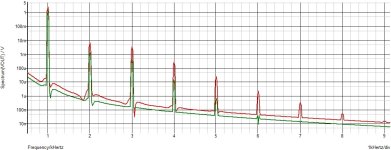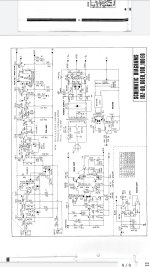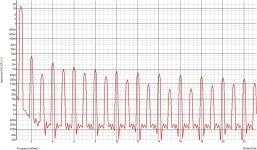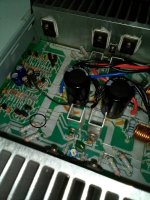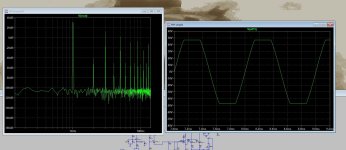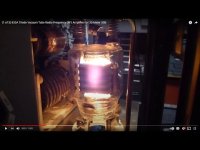I am probably a really strange soul, but whenever I want "Tubesound" from an amp, I pick up a Tube-amp and connect it.
I see no reason at all for trying to make artificial tubesound in an transistoramp, having the possibility to use the real stuff.
And introdusing distortion in an amp to make it sound......poorer?
I see no reason at all for trying to make artificial tubesound in an transistoramp, having the possibility to use the real stuff.
And introdusing distortion in an amp to make it sound......poorer?
Member
Joined 2006
Wondering if anyone had captured the circuit in the OP by repair guy, I am fascinated by his description on this amp, and if so, would appreciate if you could post it here. Thanks! 😀
I think this is it. I remember the single diode bias on the output stage. My thinking was that the NPN was silicon and the PNP was germanium.

I once built such a simple circuit - even simpler - for someone who claimed that it sounded like his 300B SE;-)
A transistor will never sound like a tube because the active elements are pressed in or pressed on. Moreover, usually in some kind of plastic. And the shape and size are also different. The active elements of a tube swing free. This is the main reason for the different sound of these parts.
However, something can be done about transistors: Heat sink tone, insulating washer tone und and also cutting of transes and working with other swinging and resonating and damping materials and elements.
Harmonics are not as relevant as claimed.
My experience only;-)
A transistor will never sound like a tube because the active elements are pressed in or pressed on. Moreover, usually in some kind of plastic. And the shape and size are also different. The active elements of a tube swing free. This is the main reason for the different sound of these parts.
However, something can be done about transistors: Heat sink tone, insulating washer tone und and also cutting of transes and working with other swinging and resonating and damping materials and elements.
Harmonics are not as relevant as claimed.
My experience only;-)
There are said to be quite a few electronics engineers who, after decades of tinkering with audio devices, still haven't noticed that parts sound different;-)
I have an exercise for audio enthusiasts: try to get the transistor BU508A to have the colors of this picture of the video(-:
I have an exercise for audio enthusiasts: try to get the transistor BU508A to have the colors of this picture of the video(-:
try to get the transistor BU508A to have the colors of this picture of the video(-:
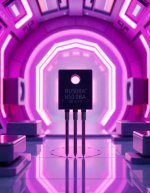
As for schematic request.
Curious as well.
It is actually rather easy to make .1% to .01%
" tube" distortion amplifier with solid state.
Including asymmetrical clipping.
Nothing special.
Been musician all my life
and heard endless " tone" babble Gibble jabber.
If musician says it sounds "tube"
ignore them.
It is easy to fool them as done by OP
One can take an amp with ppm level THD and insert a preamp stage that will emulate the desired
distorsion profile, FI this the Ibanez EQ 100 guitar amp preamp output signal when driven through its high gain input,
the output levels are 1V pk and 2V pk, see how the THD rise by 15-20db while the output level rise by only 6dB
all while producing the same harmonic profile.
distorsion profile, FI this the Ibanez EQ 100 guitar amp preamp output signal when driven through its high gain input,
the output levels are 1V pk and 2V pk, see how the THD rise by 15-20db while the output level rise by only 6dB
all while producing the same harmonic profile.
Attachments
Member
Joined 2006
It is a multiband / peak cut EQ
So yes is useful for med to high distortion guitar.
Being most the magic to good distortion.
Is pre and post filters. And with distortion=
Cutting certain frequencies.
Multiband is usually wide boost and narrow cut.
That is most the magic to good " guitar" or instrument distortion.
Is narrow cuts. Your either cutting harsh harmonics from the instrument.
Or in the end cutting the harsh frequencies of typical guitar speakers.
It is not a tube or transistor magic diodes or all the other jibble jabble
.The musican wants so much sustain and saturation from gain stages.
blues/ metal blah blah
then a butt load of pre filters and after filters to make it work.
Clipping is clipping. And eventually to much magic " asymmetrical"
clipping sounds like a broken fart like many " fuzz" tones.
Very old trick with " EQ" distortion as noted.
Its on 9 volts and distorts easy with too much gain into
it. Its a " amp in a box" rather fet or bjt or opamps.
The filters do the magic. But you can drive it too hard
and it distorts. Its like a magical multiband distortion.
Or like a zillion early amp "simulators" basically distortion pedals
with lots of multiband EQ to clean up the distortions, then another
EQ to " emulate" speaker response.
So yes is useful for med to high distortion guitar.
Being most the magic to good distortion.
Is pre and post filters. And with distortion=
Cutting certain frequencies.
Multiband is usually wide boost and narrow cut.
That is most the magic to good " guitar" or instrument distortion.
Is narrow cuts. Your either cutting harsh harmonics from the instrument.
Or in the end cutting the harsh frequencies of typical guitar speakers.
It is not a tube or transistor magic diodes or all the other jibble jabble
.The musican wants so much sustain and saturation from gain stages.
blues/ metal blah blah
then a butt load of pre filters and after filters to make it work.
Clipping is clipping. And eventually to much magic " asymmetrical"
clipping sounds like a broken fart like many " fuzz" tones.
Very old trick with " EQ" distortion as noted.
Its on 9 volts and distorts easy with too much gain into
it. Its a " amp in a box" rather fet or bjt or opamps.
The filters do the magic. But you can drive it too hard
and it distorts. Its like a magical multiband distortion.
Or like a zillion early amp "simulators" basically distortion pedals
with lots of multiband EQ to clean up the distortions, then another
EQ to " emulate" speaker response.
That s a hell of a preamp, i bought this amp in the late 80s from a friend to be used in a cultural centre,
i serviced it from day one as it was noisy and needed all cables to be shortened and eventualy shielded, the output transistors
were previously replaced by a pair of 2N3773, after wich it was used by both amateurs and pro guitarists, one of the latter told me
that it kind sounded like a Mesaboogie, wich is certainly due to the 6 bands equalizer as the distorsion itself is more like Ibanez s famed Tube Screamer.
@CFT, i wouldnt engage in building part of the preamp circuitry, the THD profile can easily be emulated by two transistors
connected in serial with both as common emitters, or eventually two fets in common source, or why not, a combination
of a fet and a bipolar, and using two devices in serial and common emitter/source will keep the phase unchanged.
i serviced it from day one as it was noisy and needed all cables to be shortened and eventualy shielded, the output transistors
were previously replaced by a pair of 2N3773, after wich it was used by both amateurs and pro guitarists, one of the latter told me
that it kind sounded like a Mesaboogie, wich is certainly due to the 6 bands equalizer as the distorsion itself is more like Ibanez s famed Tube Screamer.
@CFT, i wouldnt engage in building part of the preamp circuitry, the THD profile can easily be emulated by two transistors
connected in serial with both as common emitters, or eventually two fets in common source, or why not, a combination
of a fet and a bipolar, and using two devices in serial and common emitter/source will keep the phase unchanged.
Ah , cool "Quasi Complementary Output". Wonder if that type of OS has a distinctive sound.Ibanez Eq 100 combo manual and circuit. 😀👆
And yes , I DO believe different amps can have different sound - (OS type, damping , VAS type) plus how the circuit interacts
with the load (speakers + Xover).
OS
Dunno if that can be called a distinctive sound since with relatively low THD there s not much to hear,
although this one has quite high ratio compared to HiFi amps, but QCs have this property to produce even
harmonics with higher amplitude than the odd ones.
Of course this will apply as long as the OS is not gain starved at higher power, at wich point H3 will be dominant
like with any complementary OS that is also Hfe limited.
FTR that s the kind of harmonic profile of this Ibanez at 15V pk output level, the x axis is left linear so the respective
harmonics amplitudes up to 20Khz are better visible.
although this one has quite high ratio compared to HiFi amps, but QCs have this property to produce even
harmonics with higher amplitude than the odd ones.
Of course this will apply as long as the OS is not gain starved at higher power, at wich point H3 will be dominant
like with any complementary OS that is also Hfe limited.
FTR that s the kind of harmonic profile of this Ibanez at 15V pk output level, the x axis is left linear so the respective
harmonics amplitudes up to 20Khz are better visible.
Attachments
The Ibenez also bootstraps the VAS. VAS is directly fed OS LCR/speaker interactions. Like my present experiment (Sonance amp) , it feeds HF
(lead capacitor) back to the IPS. Strange it has such a pleasant sound for such a simple high(er) THD circuit (below).
I have a Wolverine pair that doesn't do too much better (brushes).... even at it's over-rated PPM spec !
PS - sonance does not take NFB right at the output (circled in pix) , will add two yellow wires to feed right from the actual outputs. Ceramics will
be silver mica , all new caps , as well. This amp is not as clear with brushes and other HF. Built for 34 years of service - NOT super Hi-fi...
I also increased the OL gain and tweaked the lead/lag - C5+7 values to give better phase response.
I most likely will be blasting my synth through this thing...
OS
(lead capacitor) back to the IPS. Strange it has such a pleasant sound for such a simple high(er) THD circuit (below).
I have a Wolverine pair that doesn't do too much better (brushes).... even at it's over-rated PPM spec !
PS - sonance does not take NFB right at the output (circled in pix) , will add two yellow wires to feed right from the actual outputs. Ceramics will
be silver mica , all new caps , as well. This amp is not as clear with brushes and other HF. Built for 34 years of service - NOT super Hi-fi...
I also increased the OL gain and tweaked the lead/lag - C5+7 values to give better phase response.
I most likely will be blasting my synth through this thing...
OS
Attachments
There is ONE factor we are forgetting .... Tube amps have a output trafo !
The valves can saturate the core which also has inductance.
Without that big block of steel , the typical EF-X stage will clip with "gobs" of odd order distortion.
That is , even if the circuit is even order dominant short of overload. (below)
The only application I've seen of a BJT running through a output trafo is in those 70V PA commercial
systems. They are robust , you can clip and distort all day though a School intercom setup !
OS
The valves can saturate the core which also has inductance.
Without that big block of steel , the typical EF-X stage will clip with "gobs" of odd order distortion.
That is , even if the circuit is even order dominant short of overload. (below)
The only application I've seen of a BJT running through a output trafo is in those 70V PA commercial
systems. They are robust , you can clip and distort all day though a School intercom setup !
OS
Attachments
In addition to the tonal influences of design, material, diameter and others (#44), I would also like to point out the circuit concepts:
Roughly: single-ended or push-pull or complementary-parts-half-wave-symmetrical-pp or complementary-parts-half-wave-unsymmetrical-pp. A tube pp sounds different from a tube se: reason: even components from the same batch sound audibly different - the ear, hearing is far more sensitive as is claimed: it is a difference detector. And transistors also have this problem. If then different components (complementary) amplify half-waves separately..., if then the half-waves are also constructed differently, unsymmetric, i.e. amplify the signal half-wave unsymmetric...-)
This leaves us with a look at the various characteristics of a sound too: sound is a complex concept, a complex event.
Roughly: single-ended or push-pull or complementary-parts-half-wave-symmetrical-pp or complementary-parts-half-wave-unsymmetrical-pp. A tube pp sounds different from a tube se: reason: even components from the same batch sound audibly different - the ear, hearing is far more sensitive as is claimed: it is a difference detector. And transistors also have this problem. If then different components (complementary) amplify half-waves separately..., if then the half-waves are also constructed differently, unsymmetric, i.e. amplify the signal half-wave unsymmetric...-)
This leaves us with a look at the various characteristics of a sound too: sound is a complex concept, a complex event.
I have read of 200W tube amps made with 3-4KV plates (833A tubes) and a special toroid that can match the headroom
of a 3-4 pair EF3 BJT amp.
I has NFB but still needs a output trafo , so NO PPM tube amp. maybe .1- .5% @ 180W/8R.
Edit , .5% H2 will still sound like a BIG tube amp.
OS
of a 3-4 pair EF3 BJT amp.
I has NFB but still needs a output trafo , so NO PPM tube amp. maybe .1- .5% @ 180W/8R.
Edit , .5% H2 will still sound like a BIG tube amp.
OS
Attachments
- Home
- Amplifiers
- Solid State
- Tube sound from a transistor amp, it's possible
